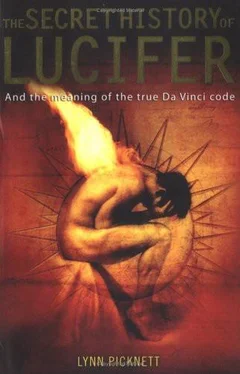Nevertheless, Set ruled over a physical realm - an actual, geographical location - that the Egyptians knew from their everyday experience to be nightmarish. With only their narrow strip of verdant land hugging both banks of the Nile, on which they were totally dependent for food, they were vulnerable to famine and recognized the hellishly inhospitable nature of the surrounding `red' desert - which was Set's kingdom. The Egyptians hated anything red, as can be seen from an invocation to Isis: `Free me from all red things' 93 In his alter ego as Typhon, Set was called `the red-skinned one' 94
Yet Set's desert was exactly the same environment that the Old Testament God Yahweh seemed to favour, as he led Moses and the Israelites out of Egypt, as a cloud by day and a pillar of fire by night. Indeed, he seemed curiously loath to let his nomadic people escape from the never-ending wilderness, managing to keep them wandering on its sand for `forty years' (usually taken to mean simply `a long time'), while they managed to travel just as many miles, apparently going round in circles. And like a typical desert dweller, in the story of Adam and Eve's fall, Yahweh prefers to walk `in the garden in the cool of the day' 95 Luckert writes:
As a desert god, Seth was known among Egyptians as the god of foreigners, of thunder, lightning and earthquakes ... It has been told that Moses spoke to the Pharaoh in the name of the God of the Hebrews. (Exodus 5:3). To an Egyptian pharaoh that meant in the name of Seth. [• •] The God who killed the firstborn sons of the Egyptians would have been Seth to them, the very god of desert-dwellers 96
It is interesting that Set combined the characteristics of both Yahweh and Lucifer, especially his association with lightning. The Egyptian pharaohs also descended into the earth as the serpent Sata, father of lightning, before their triumphant ascent into the heavens as the resurrected Osiris, where they literally became a star. The devout believed they could become immortal like Sata, by repeating the prayer in which they identified with him:
I am the serpent Sata, whose years are infinite. I lie down dead. I am born daily. I am the serpent Sata, the dweller in the utter most parts of the earth. I lie down in death. I am born. I become new, I renew my youth every day 97
In the Gospel according to Luke Jesus describes Satan `as lightning fall from heaven.'98 Yet the nearest Egyptian god to the bright star Lucifer was the hawk-headed Horus, magically conceived by Isis and the murdered Osiris. Horns was Set's sworn enemy - so reminiscent of the Israelites' Yahweh, was no benevolent deity. But although he delighted in human folly, as we have seen, he had his uses. The Gnostics, like the ancient Egyptians - who rejoiced in the ultimate balancing triad, their Trinity of Father, Mother and Child - also saw a sort of essential balance in Good and Evil, the glue that kept the cosmos together. The Gnostic Gospel of Philip (rediscovered after nearly 1,500 years at Nag Hammadi in Egypt in 1945)99 makes the point that: `The Light and the Darkness, life and death, right and left, are brothers one for another."00
A contemporary of the heretic Marcion, the Egyptian Valentine, arrived in Rome in 139 CE and caused an enormous stir, not least because of his `complex, cluttered, emanationist mythology aimed primarily at the problem of evil' .10' Yet running beneath all his babblings about eight `higher aeons' and at least twenty-two lower ones that in his fevered world view encompassed the nature of the deity, was a straight challenge to the notion of original sin. He believed that Adam and Eve's rebellion against the evil Creator god was a gift to humankind, and the snake its benefactor for making us wise to the principles of good and evil, which Yahweh was intending to keep from us.
Largely because of this concept, other Gnostic groups, such as the Ophites (from the Greek ophis, `snake') developed the tradition of the `fortunate Fall' (felix culpa). Because of original sin, man could transcend puerile ignorance - or perhaps foolish innocence - and begin to make progress towards his own god-like status. But to most Gnostics, the snake remained the evil `dragon', as in the New Testament Book of Revelation:
And there was a war in heaven. Michael [the archangel] and his angels fought against the dragon, and the dragon and his angels fought back. But he was not strong enough, and they lost their place in heaven. The great dragon was hurled down - that ancient serpent called the devil, or Satan, who leads the whole world astray. He was hurled to the ground, and his angels with him."'
However, although Luckert notes that both Set and Yahweh were associated with the hated colour red103 it has been argued that the `Scarlet Woman' of the New Testament's apocalyptic Book of Revelation owed her inspiration to a female Egyptian deity, the lioness-headed Sekhmet. Goddess of flame and destruction (like the Hindu Kali), her very fearsomeness seems to have inspired particular terror in the heart of Saint John the Evangelist, who is generally believed to have written the last book of the Bible. Although his authorship is by no means certain, there would have been a certain irony for - as we shall see - perhaps he had his own reasons for appreciating the archetypal Feminine.
The myth of Eve's fall came to associate all women and the concept of evil, but there are good reasons to link a certain historical woman with the powerful attraction of Lucifer ...
CHAPTER TWO
The Devil and All Her Works
Sacrilegious and bizarre though it may seem to believers, arguably even the Bible does not claim that God, the Heavenly Father, created the world - or at least, that he did so alone and unaided. Although carefully obscured by both Jewish and Christian priests in the millennia since Genesis was compiled, the Hebrew that has been translated as the singular `God' in the creation passages is actually the plural elohim, just as cherubim means more than one cherub. And by implication elohim encompasses both male and female - gods and goddesses.
However, elohim is often shortened to El, or God (Ale or Allah in Arabic), giving the spurious impression of one male god as ruler and creator of everything, while apologists continue to protest that the plural is merely used to indicate a plenitude of might. Be that as it may, the fact remains that even the familiar Yahweh was not alone at the beginning of all human life, for even that alpha and omega of male supremacy once had a wife.
Not only that, but in some versions of the story, she gave birth to Lucifer, while in others she had taken him as her lover. Worse, she herself had tumbled terribly from grace in men's eyes, becoming a demon, and metaphorically carrying all women with her. Together with Eve's fondness for fruit and snakes, the apparently shameful exit of God's wife from her exalted place as his consort and helpmeet underpinned the collective unconscious of the Jews, followed by that of the Christians. The concept of women as unreliable, unpredictable pawns of the Evil One (and Eve at least had yet to experience premenstrual tension) informed their treatment of wives and daughters even up to the present day.
Wives were a problem for God from the beginning. According to Hebrew legends, Adam's first spouse was not the infamous Eve grown from his spare rib, but the even more troublesome Lilith, although she began life as the Canaanites' revered Baalat ('Divine Lady'). The story goes that as poor Adam was bored with having to take his pleasure with the beasts of the field he was compelled to marry Lilith (who must have been very flattered). It was not to be a marriage made in heaven, especially as she refused to obey the rules of Yahweh because she knew his secret, ineffable name.'
The new husband was appalled by Lilith's assertiveness in bed: she refused to lie beneath him in the `missionary position' (anything other than the man-on-top position has traditionally been denounced as `accursed' by both Muslims and Catholics). Unimpressed by Adam's declarations of male supremacy in which he cited God as his authority, she taunted his sexual technique before using her convenient wings to fly away. Then when God's angels arrived to take her back, she cursed them and threw herself enthusiastically into orgiastic sex with `demons', who apparently knew a thing or two about pleasing a lady, producing a hundred children a day - all, of course, devilish.
Читать дальше












